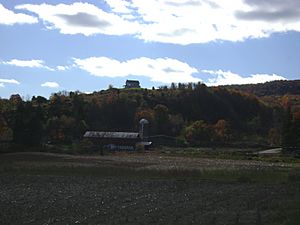Rutan Hill facts for kids
Rutan Hill is a special hill in New Jersey, sometimes called Volcanic Hill. It's located in Wantage Township, Sussex County, about 2.46 miles (3.96 km) south-southwest of Colesville. Rutan Hill rises about 270 feet (82 meters) above the nearby creek valley, reaching a height of just over 1020 feet (311 meters). This hill is on private land. It's actually the top part of an ancient volcanic pipe, called a diatreme, which is part of a larger group of rocks known as the Beemerville Alkaline Complex. This complex formed a very long time ago, during the Late Ordovician period.
Contents
What is the Beemerville Complex?
The Beemerville Alkaline Complex is a group of interesting rock formations that appear on the surface. It includes two large rock bodies called nepheline syenite plutons, which are like big underground blobs of cooled magma. Rutan Hill itself is one of the volcanic pipes (diatremes) in this complex. There are also many smaller cracks in the Earth, called dikes and sills, which are filled with ancient cooled lava.
Where are these rocks found?
The two large plutons are located south-southwest of Rutan Hill. They are found where two different rock layers, the Martinsburg and Shawangunk formations, meet, and also on the southeast side of the Kittatinny Mountains. The dikes and sills are made of different types of volcanic rocks like phonolite or carbonatite.
What's inside the volcanic pipes?
The volcanic pipes, like Rutan Hill, often contain xenoliths. These are pieces of other rocks, like sedimentary rocks and gneiss, that were picked up and carried by the magma as it moved upwards. They also contain "autoliths," which are pieces of the same magma that cooled and broke off.
Rutan Hill: An Ancient Volcanic Throat
Rutan Hill is the biggest of the volcanic pipes (lamprophyric diatremes) in the Beemerville Alkaline Complex. Inside this pipe, there's a small plug of nepheline syenite rock, about 30 meters (98 feet) wide. This plug is filled with many angular and subangular xenoliths and autoliths.
What rocks are found at Rutan Hill?
The xenoliths found here include pieces of shale, graywacke, pale-blue dolomite, cream-colored limestone, and gneiss. The autoliths are made of nepheline syenite, micromelteigite, and carbonatite. The main rock around these pieces is very fine-grained, but it also contains larger crystals of minerals like biotite, diopside, augite, orthoclase, magnetite, apatite, and nepheline.
A Deeper Look at the Beemerville Complex
Rutan Hill and the Beemerville Alkaline Complex are just the parts we see on the surface. They are actually the top of a much larger body of igneous rock that lies beneath the ground in the Beemerville, New Jersey area. This large rock body is part of an even bigger chain of igneous rocks called the Cortlandt-Beemerville magmatic belt.
The Cortlandt-Beemerville Belt
This belt stretches across parts of northern New Jersey and southeastern New York. The Cortlandt complex in New York marks the eastern end of this belt. Between the Beemerville complex and the Cortlandt complex, this magmatic belt mostly consists of a long, almost east-west line of dikes made of lamprophyre and felsic rocks.
How Old is Rutan Hill?
Scientists have used special dating methods to figure out the age of the Beemerville Alkaline Complex. The most accepted age for when these rocks formed is about 420 million years ago, give or take 6 million years. This age was found by studying a mineral called titanite using a method called fission track dating.
What do the dates tell us?
Older studies using different methods, like Rb-Sr and K–Ar dating on biotite from the nepheline syenite, gave similar ages of about 435 million years ago. All these dates agree with what geologists observe: the dikes of the Beemerville Alkaline Complex cut through older rock layers that were already folded and layered. However, they don't seem to cut through any younger rocks.
Rutan Hill: An Ancient Volcano's Remnant
Based on how volcanic pipes (diatremes) form, scientists believe that the diatreme which makes up Rutan Hill is the throat of a very old, extinct volcano. Imagine a volcano that erupted a long, long time ago!
Where did the volcano go?
After the volcano erupted, erosion (like wind and water wearing away the land) has either completely destroyed the original volcanic cone and any ash or lava that was on the surface, or those deposits are now buried deep underground. Scientists haven't found any signs of them on the surface in the Beemerville area today.
Why Did This Volcano Form?
This group of igneous rocks formed, and the volcanic activity happened, during the end of a major mountain-building event called the Taconic Orogeny. This was in the late Ordovician period.
Tectonic Activity
The fact that this volcanic activity happened at the same time as the Taconic Orogeny suggests it might be linked to cracks forming in the Earth's mantle. These cracks could have appeared where two major tectonic plates collided in the New York region. This type of volcanic activity is unusual for an area where mountains were being pushed up by compression. At that time, the western part of the Iapetus Ocean was closing, with one part of the Earth's crust sliding beneath another (a process called subduction) under the Taconic Island Arc.
Images for kids



